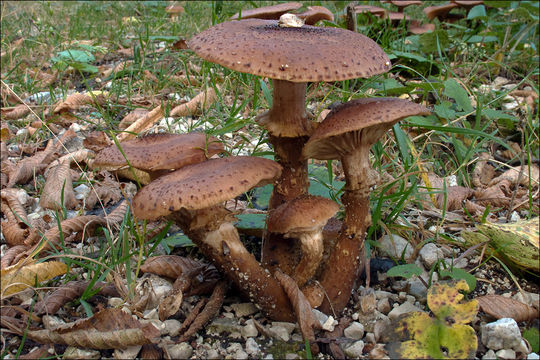Image of Armillaria ostoyae (Romagn.) Herink 1973

Description:
Slo.: rnomekinasta mraznica - syn.: Armillariella ostoyae Romagn, Armillaria obscura (Schaeff.) Herink, Armilaria polymyces (Pers. ex Gray) Singer & Clemencon - Habitat: A widening of a dirt forest road lightly overgrown with grasses and other green plants, semi ruderal place of former forestry activities; mountain slope, south aspect; relatively warm place; locally flat, calcareous ground with a lot of half buried and buried Picea abies and Fagus sylvatica thrown away wood pieces; sunny, open place, exposed to direct rain; average precipitations ~ 3.000 mm/year, average temperature 6-7 deg C, elevation 870 m (2.850 feet), alpine phytogeographical region.Substratum: sand and gravel with buried pieces of wood; most probably on Picea abies.Comments: Not so far ago this find would be named Armillaria mellea (s.lat.) (aggregate). This group of very variable mushrooms is, based on inter-fertility tests, now divided into Armillaria borealis, Armillaria cepistipes, Armillaria gallica and Armillaria ostoyae (Ref.:1). Armillaria ostoyae is distinguished from other three species by its relatively dark colors, red-brown hut covered by dark scales, which are denser at its center, but extend just to the edge of the hut (and can be washed off by heavy rains). Also, its distinct, white, felted stipe ring resembles a cogwheel with brown tufted tips of the 'teeth' (see Picture 3. and 6.) This mushroom is a virulent parasite on live trees but continues to grow as a saprophyte on its victims, when they are dead. In my environment it is a rather common species usually found on stumps of Picea abies, often in large to very large colonies. This find shows rather old fruitbodies being unusual regarding their habitat. Several tens of mushrooms were growing virtually on sandy and stony flat surface of a dirt road side. However, closer inspection showed that the ground is full of buried wood, most probably of Picea abies.Mushrooms were growing in several dense, tufted groups of several fruit bodies; pileus diameter about 5 (7) cm; taste unpleasant, smell faint, indistinctive; SP abundant, whitish.Spores smooth. Dimensions: 7.3 [8.4 ; 8.9] 10 x 5.5 [6.2 ; 6.5] 7.2 microns; Q = 1.1 [1.3 ; 1.4] 1.6; N = 40; C = 95%; Me = 8.6 x 6.4 microns; Qe = 1.4. Motic B2-211A, NEA 100x/1.25, magnification 1.000 x, oil, in water, in vivo. AmScope MA500 digital camera.Ref.:(1) G.J. Krieglsteiner (Hrsg.), Die Grosspilze Baden-Wrttembergs, Band 4., Ulmer (2001), p 124.(2) S. Buczacki, Collins Fungi Guide, Collins (2012), p 190. (3) R. Phillips, Mushrooms, Macmillan (2006), p 101. (4) J. Breitenbach, F. Kraenzlin, Eds., Fungi of Switzerland, Vol.4., Verlag Mykologia (2000), p 138. (5) R.M. Daehncke, 1200 Pilze in Farbfotos, AT Verlag (2009), p 68.
Included On The Following Pages:
- Life (creatures)
- Cellular (cellular organisms)
- Eukaryota (eukaryotes)
- Opisthokonta (opisthokonts)
- Nucletmycea
- Fungi (mushrooms, lichens, molds, yeasts and relatives)
- Dikarya
- Basidiomycota (basidiomycete fungi)
- Agaricomycetes (Mushroom-Forming Fungi)
- Agaricales (Gilled Fungi)
- Physalacriaceae (Physalacria and relatives)
- Armillaria (Honey Fungus)
- Armillaria ostoyae
This image is not featured in any collections.
Source Information
- license
- cc-by-nc-sa-3.0
- copyright
- 2016 Dr. Amadej Trnkoczy
- photographer
- Dr. Amadej Trnkoczy
- original
- original media file
- visit source
- partner site
- CalPhotos
- ID


